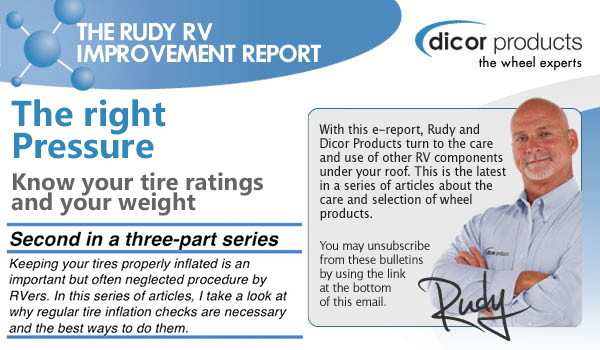|
In our last report, I discussed some negative consequences of over and underinflated tires. In this report we want to talk about how to avoid such consequences by consistently keeping your tire pressure at its optimum setting for safe, fuel-efficient and long-lasting tire performance.
To set the correct tire pressure, you need to know a few things about your tires and about your RV, how much it weighs and where that weight is placed.
On your tire's sidewall you should find the maximum load rating and maximum inflation pressure for that tire. There are also similar ratings for the wheel that you should find stamped on it. If not, ask your dealer. On your RV there should also be a placard with the minimum tire pressure required. Never let your tire pressure go above or below these specified limits.
To find your optimal tire pressure you need to know how much your RV actually weighs and how that weight is placed, making sure it does not exceed the Gross Vehicle Weight Rating (GVWR), the Gross Axle Weight Rating (GAWR) and the gross wheel weight rating (half of the GAWR). All these ratings apply to a fully loaded RV, with all the people and stuff you will have in it, along with filled water, fuel and propane tanks and the like.
You should be able to find a scale at a truck stop, RV center, farm supply place, or even gravel pit (look in the yellow pages) that will allow you to do several things: weigh the entire loaded vehicle, weigh just the front half of the vehicle for the front axle weight, just the back half of the vehicle for the rear axle weight, and to drive along the side of the scale so you can park one wheel on it at a time to get a weight for each wheel.
Here is where many RVers run into a problem: they've overloaded their RV, or the RV is overloaded on one axle (most commonly the rear) but not the other axle. Or it could be overloaded over the wheel on one side but not the other. In such instances, RVers need to either remove or redistribute weight or do both if they are to avoid over stressing the tires (and other parts of the RV!) by exceeding the capacity they were designed for. Such overstressed tires can generate excessive heat and over time result in tire failure and potentially dangerous blow-out situations.
If your weight is within the rating limits, you can find the optimal psi to use for the weight you have by consulting the tire manufacturer's chart for your tire. But again, be mindful of the maximum and minimum pressures indicated.
Once you've done all this, however, one challenge remains: keeping your tires at the right pressure. If you add or subtract people and stuff from the RV, changing the load or load balance, the proper tire pressure will change as well. And, over time, tires will naturally loose pressure. Bridgestone-Firestone estimates, depending on tire size, that a tire can lose 1 to 2 psi per month just by diffusion through the sidewalls. If there's a bad valve stem or a faulty seal between tire and wheel, or the familiar nail in the tire, you lose even more pressure. So regular, continuing pressure checks are needed to a void this "default mode" for your tires.
 And that's the problem: Bridgestone-Firestone estimates that 40 percent of RVers only check their pressure once every six months, which means by that time the tire could be down as much as 12 psi without anything being wrong with it. RVers may think their tires look all right, but as noted in our previous report, it's virtually impossible to tell with today's radial tire if it is underinflated or not just by looking at it.
Accordingly, it pays to check your tire pressure as often as you can, and the proper way to do this is when the tires are cold, before the RV has been driven, or driven not more than a mile, as driving will naturally heat the air and boost the pressure, giving you inconsistent and faulty readings. All pressure checks and fills referred to here are done with cold tires.
Tire manufacturers, in fact, recommend a frequent check schedule along these lines:
- At least once a month and before any major trips.
- On extended driving trips, check every morning before heading out.
- For short trips, a few days out and back, check before you leave and when you return.
- Before going into storage and when coming out of storage.
- Once a month while in storage.
One reason RVers may avoid pressure check is the inner tire on a dual tire set can be difficult to access and can make the whole business of checking tire pressure feel like an unwelcome chore. Because of this difficulty, the inside tire is often neglected and often underinflated, putting additional stress on the outside tire to carry the load. A simple and inexpensive remedy here is to use quality valve stem extensions for the interior tire that run out through the exterior wheel for easy access. If it’s easy to do, you’re more likely to do it — and keep your tires and RV running at peak performance. More on this in our next report.
NEXT: Valve extensions.
Come and follow Dicor on our new Facebook page! Just click on the Facebook icon!

|

